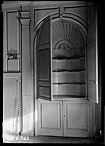Ross Hall
In 2000 the museum received a significant artifact, the Ross Hall Wall – a piece of America's past that had witnessed one of the nation's most memorable occasions. In July 1778, George Washington and 11,000 patriots were camped along the Raritan River in Piscataway. General Washington's headquarters was at Ross Hall and it was there that he wrote the order for the first national celebration of the 4th of July – a tradition that continues to this day. The troops were ordered to march across the river on Landing Lane Bridge, line the banks of the Raritan in New Brunswick, and shoot their rifles down and up the line in the first organized salute to the nation's independence. They were then given an extra ration of rum and that evening the General had a party for officers (including Alexander Hamilton, the Marquis de Lafayette and Baron Von Stuben) and their ladies at Ross Hall. The building was destroyed in the 1960s but, because of its significance, a parlor wall was saved and was exhibited at the New Jersey Historical Society until it was given to the Township and the Metlar-Bodine House. It is the intention to have this relic recognized as an "American Treasure" and interpret it, and the incredible historical moment it represents, in a new wing of the museum.
 HISTORIC ROSS HALL WALL AWAITING MUSEUM’S NEW EDUCATIONAL WING
HISTORIC ROSS HALL WALL AWAITING MUSEUM’S NEW EDUCATIONAL WING
The Ross Hall Wall, a fully paneled parlor wall, and the only remaining piece of the Edward Anthill House, an important mid-eighteenth century house in mid-Jersey, is scheduled to be reinstalled in the museum’s new educational wing.
Built in the 1740s along River Road, the house was a prominent structure in the colonial port community of Raritan Landing, Piscataway, New Jersey. In 1740 Edward Antilll built an imposing home along the banks of the Raritan River. Edward's wife Anna was the daughter of Governor Lewis Morris who served as Governor of New Jersey from 1738 until his death in 1746. Anna and Edward resided there from 1740 to 1763 when it was sold to Dr. Alexander Ross. Ross passed away right before the Revolution, in 1775, and his wife, who was a patriot sympathizer during the war, offered her home to be command headquarters in July 1778.
From July 1 to July 7, 1778, following the battle of Monmouth, the General and 11,000 continental soldiers rested along the Raritan River in Piscataway. On July 3, 1778, at Ross Hall, Washington wrote, “Tomorrow the anniversary of the Declaration of Independence will be celebrated by the firing of 13 pieces of cannon and a feu de joie of the whole line…soldiers are to make the best appearance possible. A double allowance of rum will be served out.” This order marks the first time America’s army recognized Independence Day and the first true celebration of the holiday – sporadic celebrations throughout the colonies happening in July, 1777. The Army’s tradition has continued. The festivity took place July 4, at 5:00 P.M. on the banks of the Raritan and afterwards, at Ross Hall, George Washington hosted a ball that was attended by at least 100 guests - including the Marquis de Lafayette, Alexander Hamilton, and James McHenry.
Mrs. Ross eventually remarried - her second husband Charles Howard. In 1792 Miles Smith took possession of the home from the Howards and it remained in the hands of the Smith family until 1880 when entrepreneur George Metlar became its owner. George’s heir, John Metlar (20th century owner of the Metlar-Bodine House) sold Ross Hall in the 1920s. Rutgers University owned the house in the 1950’s, but after a fire, decided to have it destroyed. Dr. Richard P. McCormick, well known Rutgers history professor, insisted that a piece of the building, its parlor wall, be saved and installed at NJ Historical Society Headquarters in Newark. It remained there until it was de-accessioned and given to the town of Piscataway and the Metlar-Bodine House Museum in 2000.
The Ross Hall Wall is a magnificent survivor of the importance of high-style design to the early occupants of the area. It confirms the presence of builders and craftspeople in Central New Jersey, who had the skills to design and construct fine examples of architectural cabinetry furniture. This fact, and the Ross Hall Wall's provenance, dating to the Revolutionary War event described above, truly makes it an American Treasure.
Currently, the wall is dismantled and in a large warehouse owned by Piscataway Township. The wall must be restored and relocated to a facility that is climate controlled and protected. It is estimated that the wall’s restoration and an addition to the Metlar-Bodine House would cost close to $1 million. Donations are currently being sought for this project.
